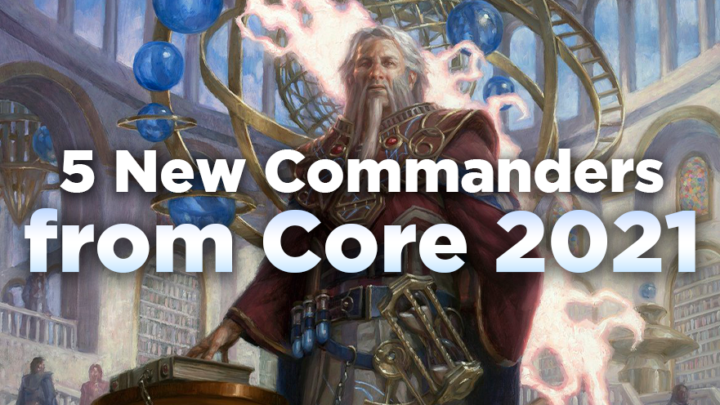This upcoming Friday, July 3rd, marks the release of Core 2021 (which you can still preorder now!). And the twentieth core set packs a suite of legendary creatures that tick all my boxes when I’m perusing the previews for my next commander:
- Cheap to cast
- Thematic
- (Mostly) mono-colored
The Wheeler philosophy of Commander is centered on taking advantage of the format’s uniqueness: diving deep into the game’s history, only to surface when I’ve found the perfect abysmal uncommon from Mirage or functional reprint from Portal Second Age. When you sit down for a game of Commander, you’re allowed to select a legendary creature of your choice to call upon whenever you see fit; that means the forgotten bulk from the annals of Magic history will finally find a home among 98 other similarly-themed cards. Add the restriction of limiting your card pool to just a single color — because why not? — and you’ve got yourself a guaranteed recipe for getting those creative juices flowing.
What better than a brand new core set to showcase this philosophy in action? Here are five Core 2021 commanders, one for each color, each built around a central theme!
Mangara, the Diplomat
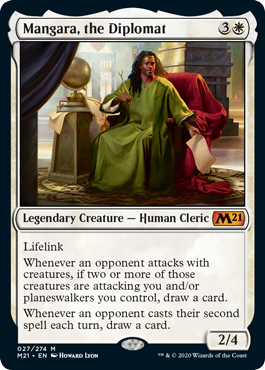
Finally, card advantage AND basic plains, together at last! Mangara provides White with much-needed repeatable card advantage without having to rely on artifacts, and does so while the other three players simply play an average game of Commander. While Mangara’s first ability may not trigger too often (lifelink on a creature with four toughness makes for an unproductive combat step), playing multiple spells each turn in Commander is a forgone conclusion.
Mangara initially stumped me as a commander, though. While both his name and his abilities suggest a political or “pillow fort” strategy, in practice, Mangara doesn’t stop your opponents from dogpiling on you after you’ve drawn one too many extra cards. I don’t have much interest in building Mangara as a less effective Baird, Steward of Argive.
But what if instead of locking down combat entirely, we created incentives for players to attack everyone except us?
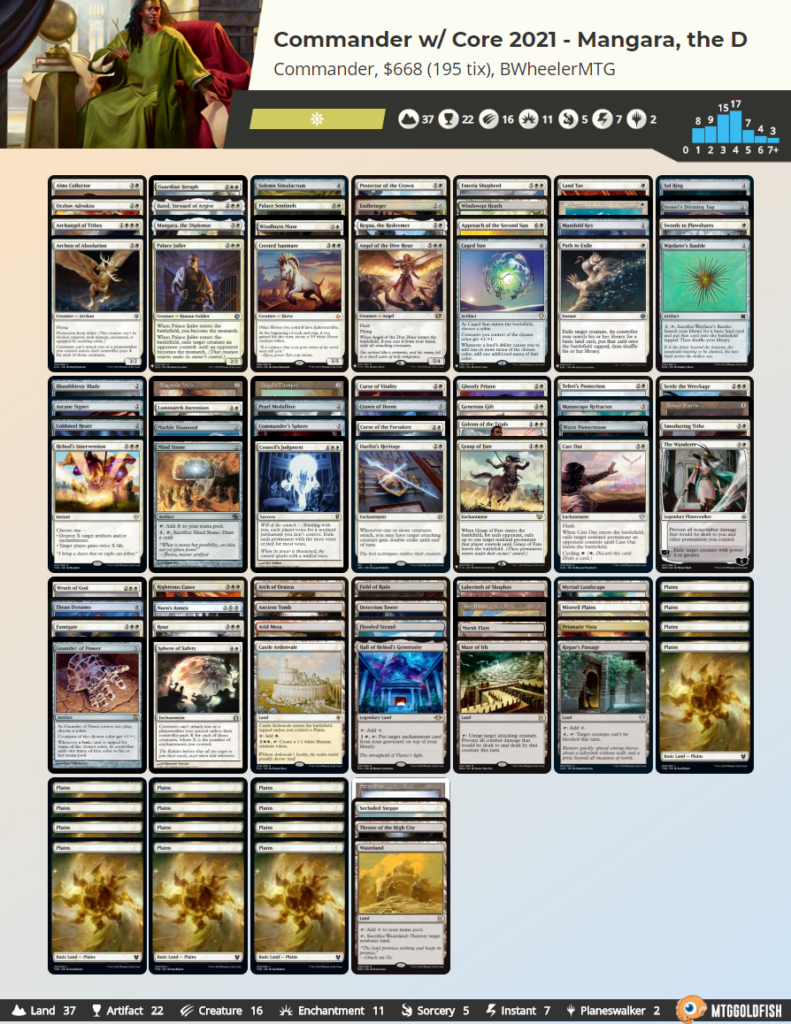
Order the full list from Card Kingdom
Mangara wound up as a more efficient version of my Patron of the Kitsune deck, which encourages constant combat but has the tools to stay out of your opponents’ squabbling. While we’re packing “pillow fort” staples such as Ghostly Prison and Sphere of Safety, think of them more as high-end camping chairs making your viewing experience from the sidelines much more comfortable. The variety of life-gain enchantments are also useful — not removing the combat step entirely, just softening the blow or making us the least appealing target. Additional bargaining chips include the repeatable buffs provided by Duelist’s Heritage, Orzhov Advokist and Power Matrix, which also provide additional muscle when Mangara looks to implement an aggressive diplomatic process.
Barrin, Tolarian Archmage
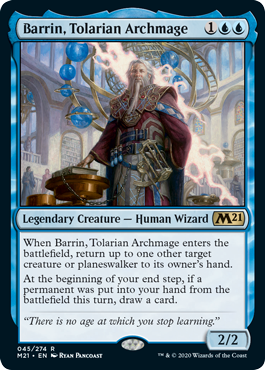
While Mangara was looking to shake off the “pillow fort” descriptor, Barrin has built himself a “bouncy castle.”
While Barrin and friends are certainly equipped to deal with opposing threats, the Archmage incentivizes us to prioritize bouncing our own threats instead. Trust me when I say there are few things more satisfying than rebuying a creature with a powerful ability — doubly so when you get an extra card for your efforts.
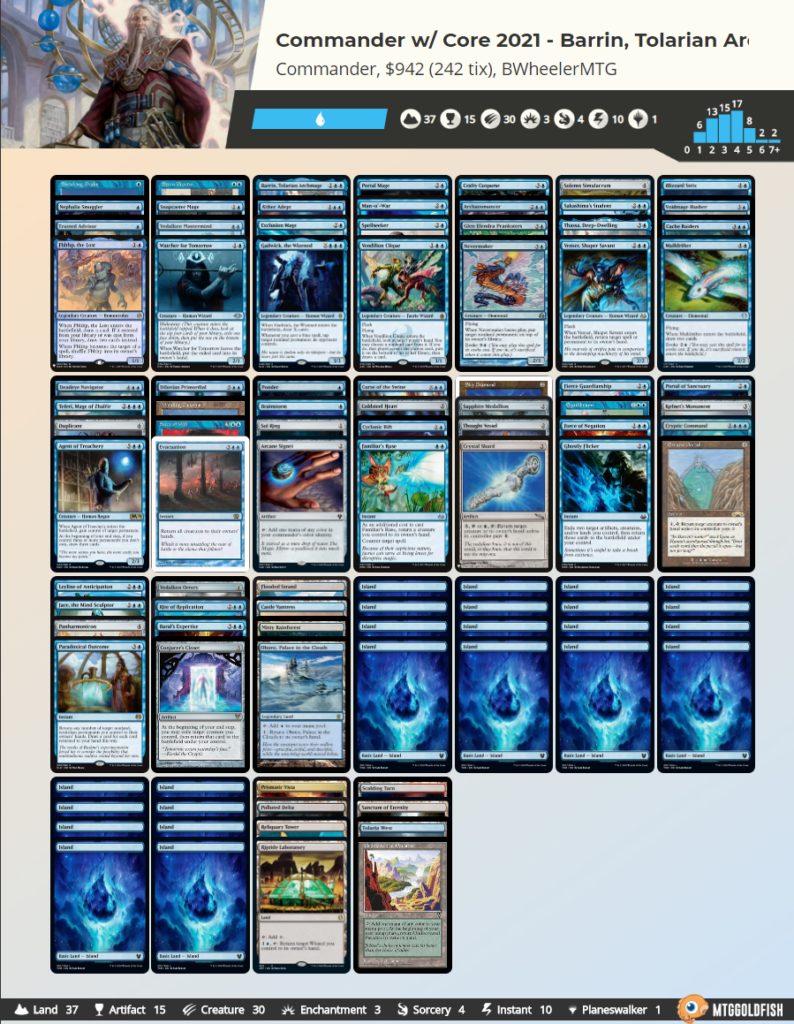
Order the full list from Card Kingdom
Whereas a commander like Naban, Dean of Iteration will have you narrowing your suite of creatures down to those of a specific tribe, this academy’s doors are open to everything from Jellyfish to Birds. Naturally, as a blue creature strategy, we’ll have our fair share of Wizards — Voidmage Husher and Venser, Shaper Savant are all-stars — but Riptide Laboratory is the deepest we’ll go when including anything resembling tribal synergies.
To take advantage of our creatures, we’re going to need some reliable tools to simultaneously protect and rebuy our threats. Barrin and fellow Man-o’-War variants offer one-time support, but they pale in comparison to the repeatable value offered by cards like Trusted Advisor, Cache Raiders or Portal of Sanctuary. While the aforementioned engines only operate on our turn — notably triggering Barrin — since we’re a blue deck, it feels only appropriate to also play on our opponents’ turns. Leyline of Anticipation and Vedalken Orrery set us up for success, while Vedalken Mastermind, Erratic Portal and my personal favorite Crystal Shard really knock things out of the park.
Vito, Thorn of the Dusk Rose

A Sanguine Bond on legs is almost cheating. Admittedly, not many players are sleeving up their copy of Defiant Bloodlord because they’re in desperate need of a seven-mana 4/5 to top off their curve. Chop four mana off that casting cost, toss that bad boy into the command zone, and you’ve got trouble.
That said, this isn’t the first time we’ve seen a Black commander with an ability ripe for exploitation.
Player: “Mom, I want K’rrik, Son of Yawgmoth!”
Player’s Mom: “We have K’rrik at home.”
K’rrik at home:

Order the full list from Card Kingdom
All joking aside, I wanted to focus on building an interesting take on Mono-Black Life Drain without the Storm components that have soured players on K’rrik decks. Now, a barrage of upkeep triggers from Subversion and Palace Siege won’t exactly lead to an “engaging” play experience, but they do reinforce a unique take on the archetype: slowly draining the table until one player finds themselves at a slightly lower life total than the others.
While we’re packing a handful of combos centered around Vito and the other Sanguine Bond variants, we’re perfectly capable of clearing the board (of opponents) with a massive Gray Merchant of Asphodel drain or a freshly deceased Kokusho, the Evening Star. But before we reach that point, we survive by the merit of our many life-gain artifacts. Sure, people laugh when your Staff of the Death Magus hits the board, but when you follow it up with a Demon’s Horn or Paradise Plume, things stop being so funny.
Gadrak, the Crown-Scourge

Gadrak is massive, and I’m not just talking about his giant head taking up a majority of the art. In addition to hitting the board quickly, an easily abusable end-of-turn ability slapped onto a 5/4 creature makes for an incredibly threatening commander. Heck, if Gadrak isn’t feeling up to attacking, just let Atog do it.
Yes, that Atog.
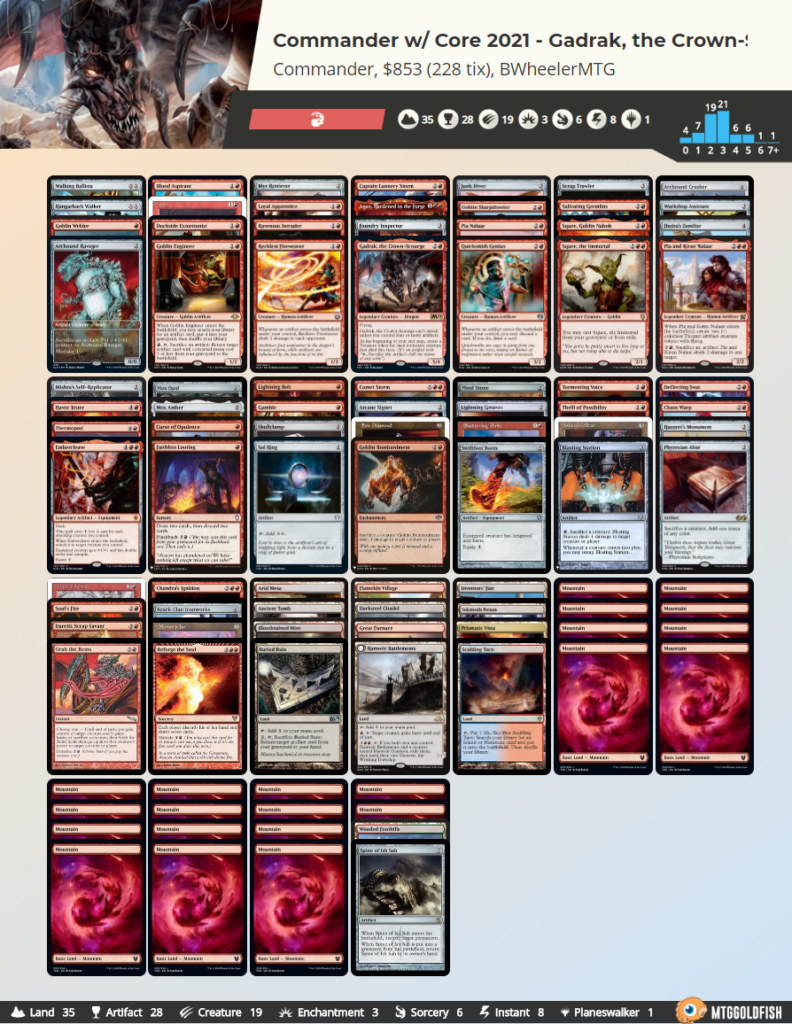
Order the full list from Card Kingdom
Gadrak is one part Anax, Hardened in the Forge and one part Teshar, Ancestor’s Apostle, but I’ve decided to add a dash of “Ravager Affinity meets Ironworks combo.” There are several loops available for a combo finish, which often involve cycling two Junk Diver variants with either a Krark-Clan Ironworks or Ashnod’s Altar (occasionally requiring a cost reducer). But let’s face it — I designed this deck to attack with a lethal Atog as often as possible. If attacking is off the menu, the treasure tokens created at the end step can still fuel a gigantic Soul’s Fire or push Reckless Fireweaver into working overtime.
Azusa, Lost but Seeking
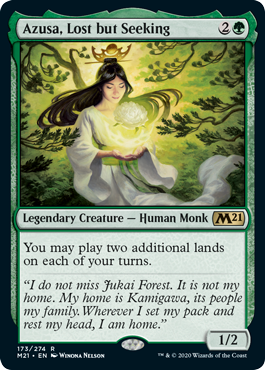
Azusa is no stranger to the commander table — in fact, she’s one of the most popular mono-green commanders in the format. Typically, you’ll find Azusa ramping out massive Eldrazi or making gigantic green creatures do her dirty work. But if you made it this far into the article, then you can probably guess that’s not our game plan.

Order the full list from Card Kingdom
DECKLIST:https://www.mtggoldfish.com/deck/3142442#paper
Recently, I’ve been enamored with “Voltron” and “battle cruiser” strategies featuring commanders that don’t traditionally take up arms. Subverting the expectations players have when they sit down across from iconic commanders is a joy I’d like to spread as widely as possible. There’s something so satisfying about suiting up and attacking with a utility legend — and, frankly, equipment like Blackblade Reforged and Strata Scythe make it quite easy to accomplish with a mono-colored commander.
If Azusa isn’t looking to rumble, or if we can’t seem to find our equipment, we’re packing enough ramp to end games with a massive Dungrove Elder or Crash of Rhino Beetles. Threats like Rampaging Baloths and Kalonian Twingrove allow us to go wide while also avoiding too much commitment to the board in the face of a potential board wipe, but Heroic Intervention and Withstand Death are pretty effective at dealing with that.
Working on Your Core
While these decks encapsulate my personal Commander philosophy, each of these legends provides enough flexibility to pack a punch no matter the direction you take them. Core 2021 isn’t just bringing a set of new exciting commanders to the format, either, and the set is packed with plenty of home-runs. I mean, I didn’t even get to the Shrines!
But if you’re interested in more Shrine-related discussion, or are looking to talk shop on any of the commanders featured today, be sure to reach out to me on Twitter or tune into my stream!

As one of the creators of Gladiator and the longest-tenured councillor for Canadian Highlander, Benjamin Wheeler is no stranger to 100-card formats. While he prefers his graveyards stacked and Lotuses black, he’s willing to saddle up with whatever needs breaking next. He’s known throughout the Magic community as The Premier Lands Pilot, as well as the Paul Rudd of LoadingReadyRun. For all your singleton questions, catch him streaming at twitch.tv/benjamin_wheeler or ask away at @BWheelerMTG.

